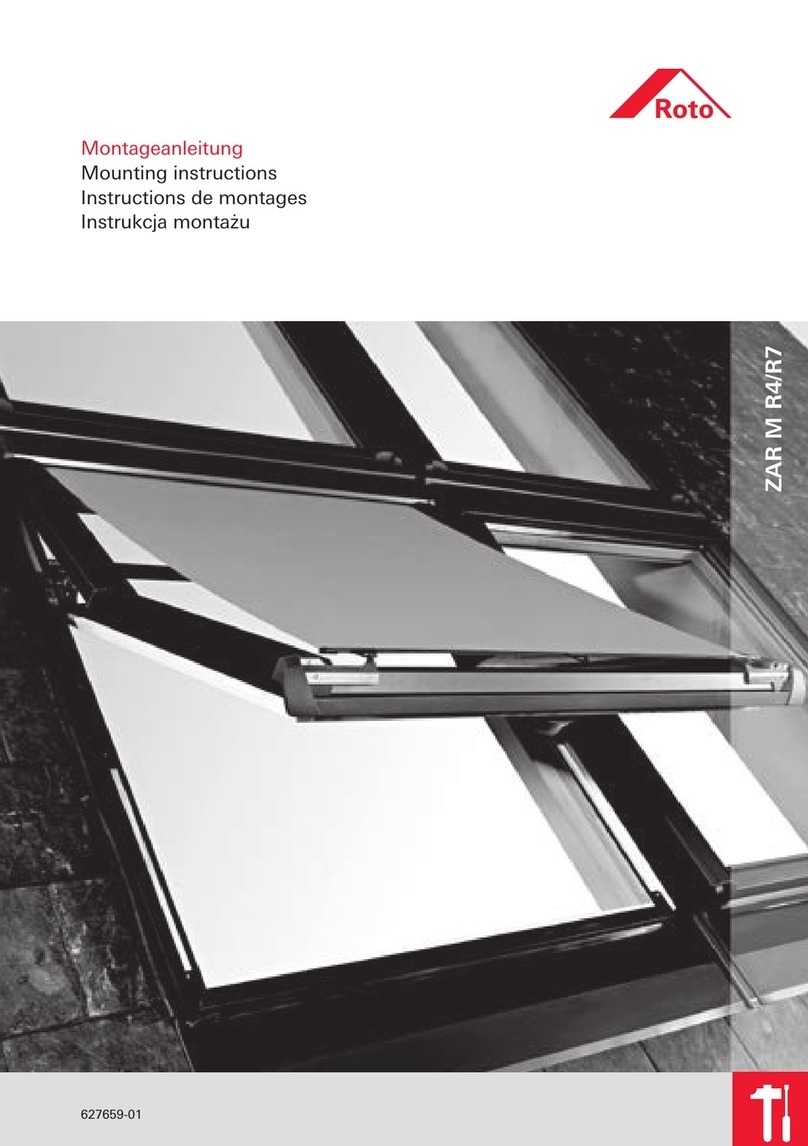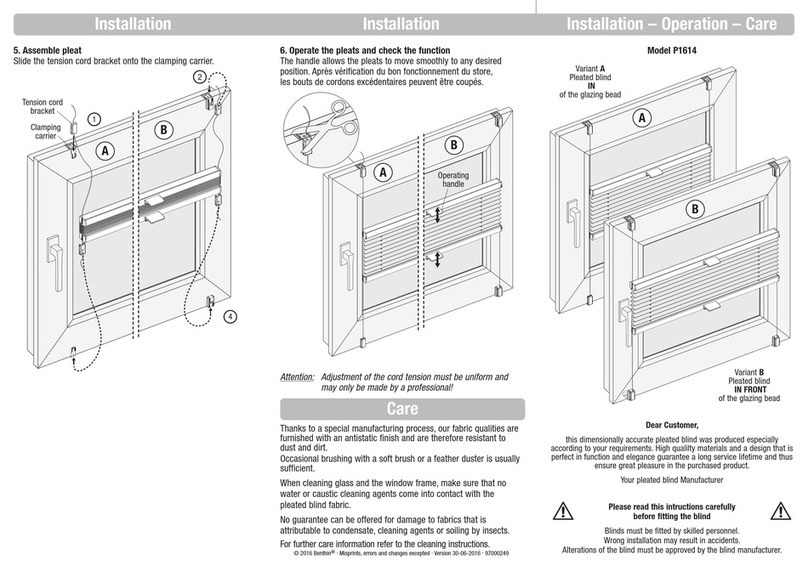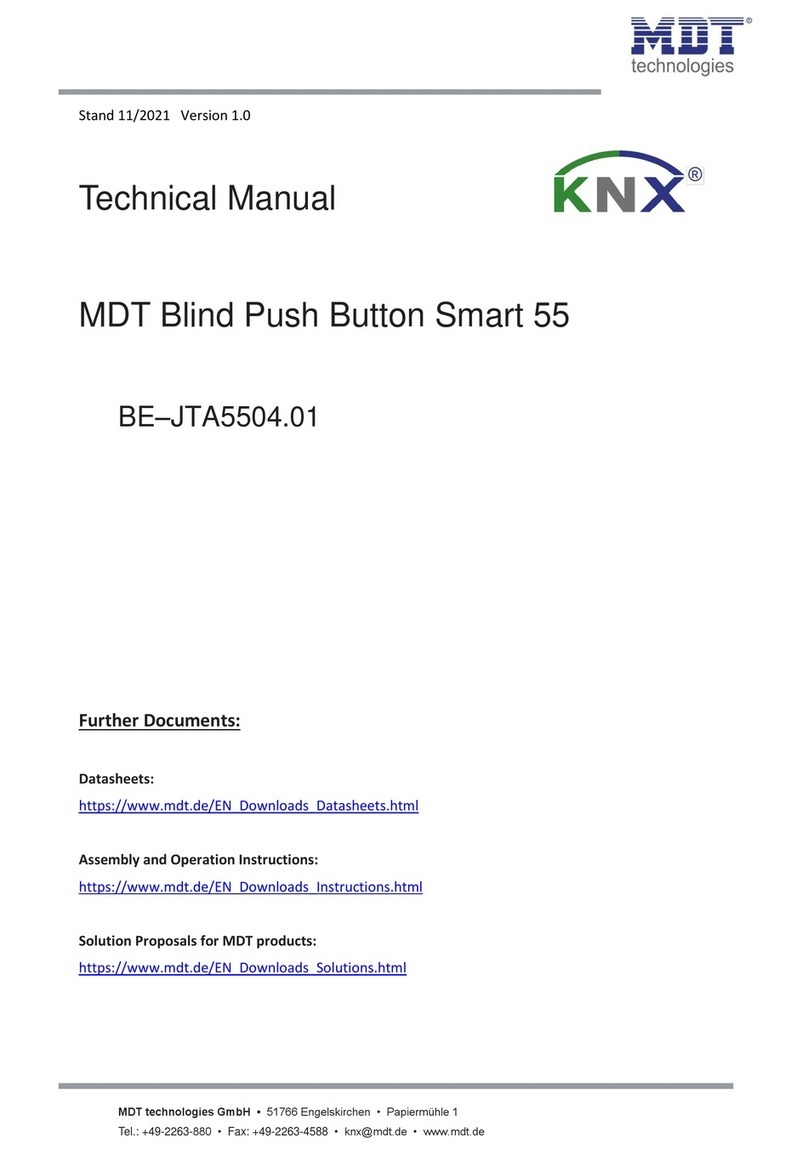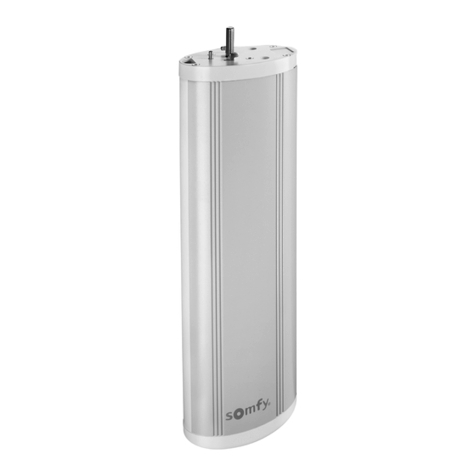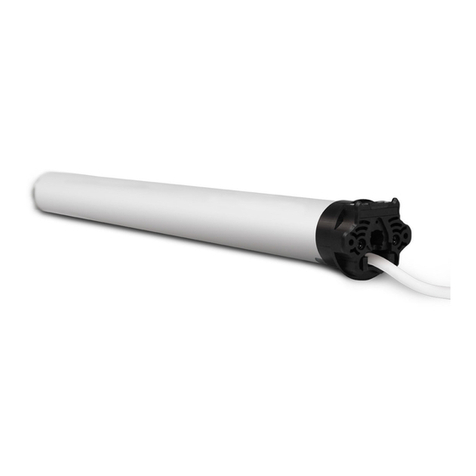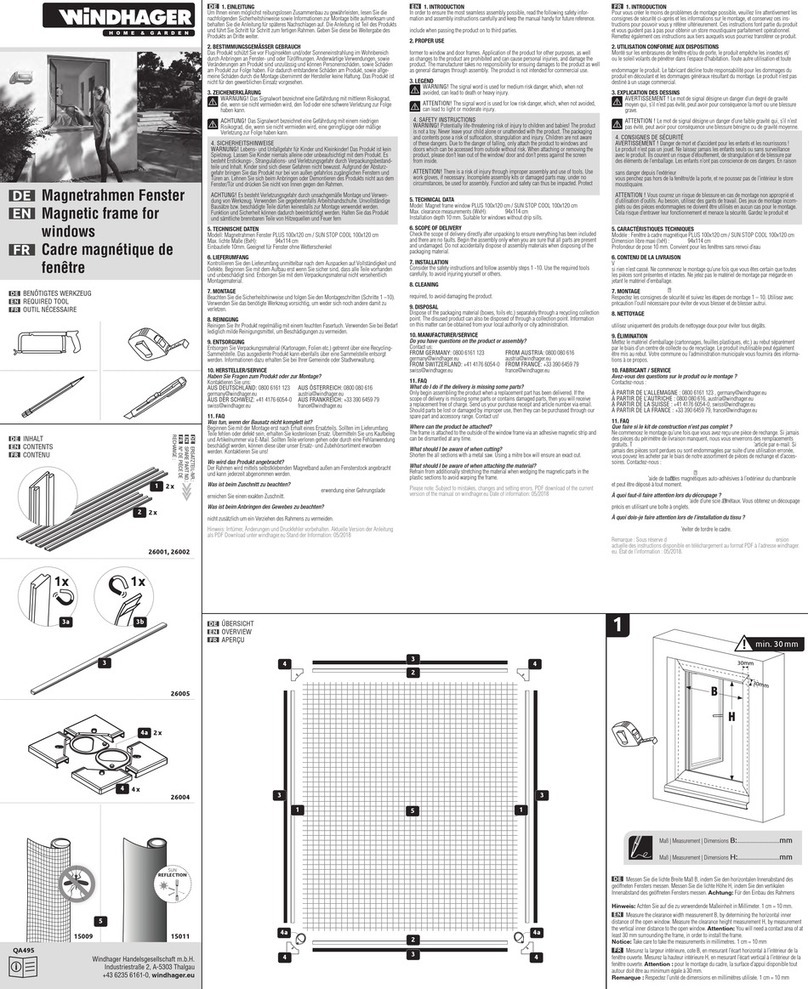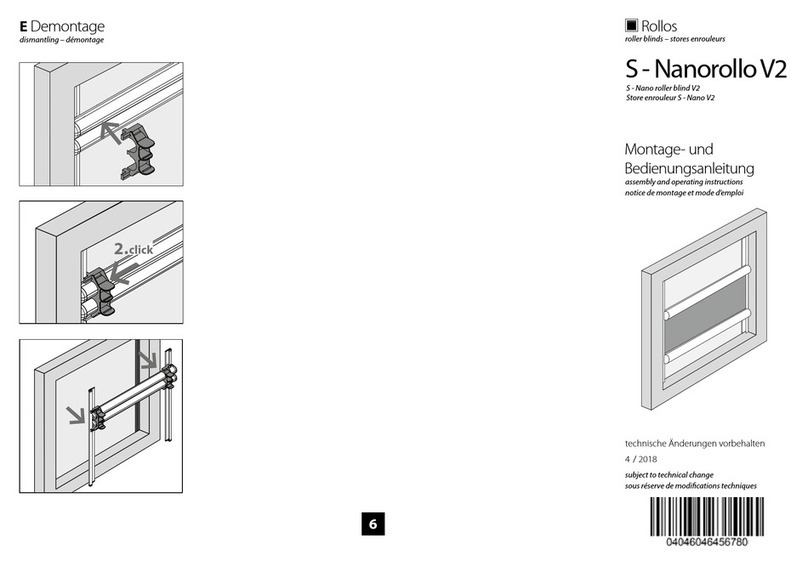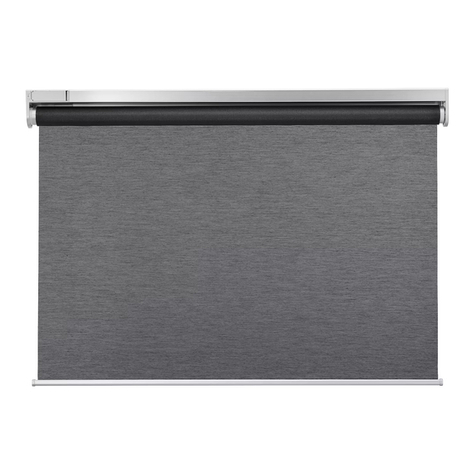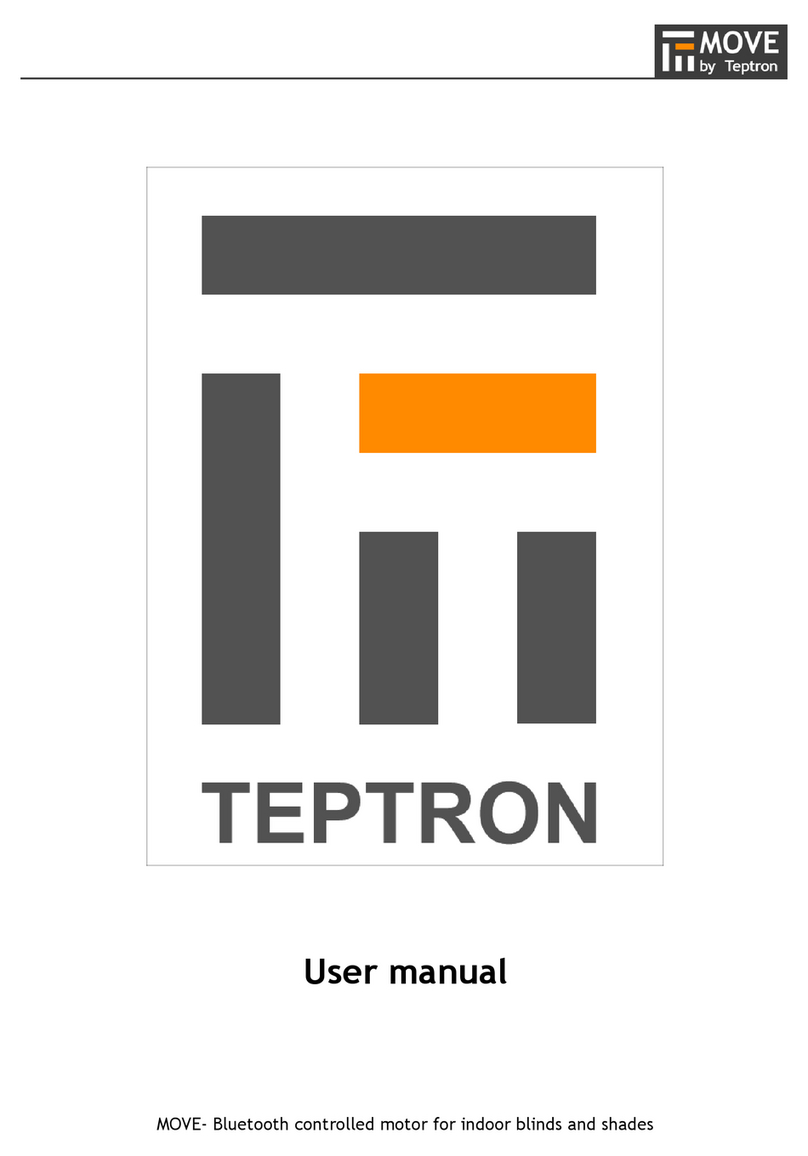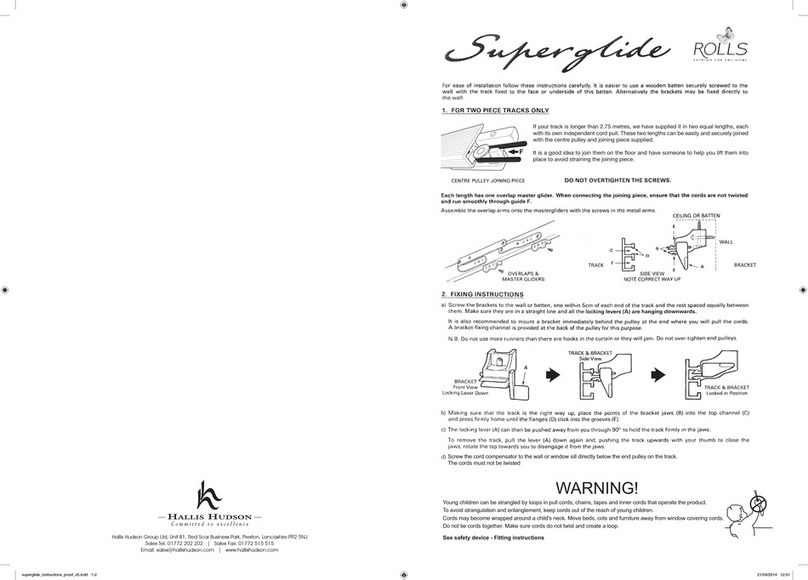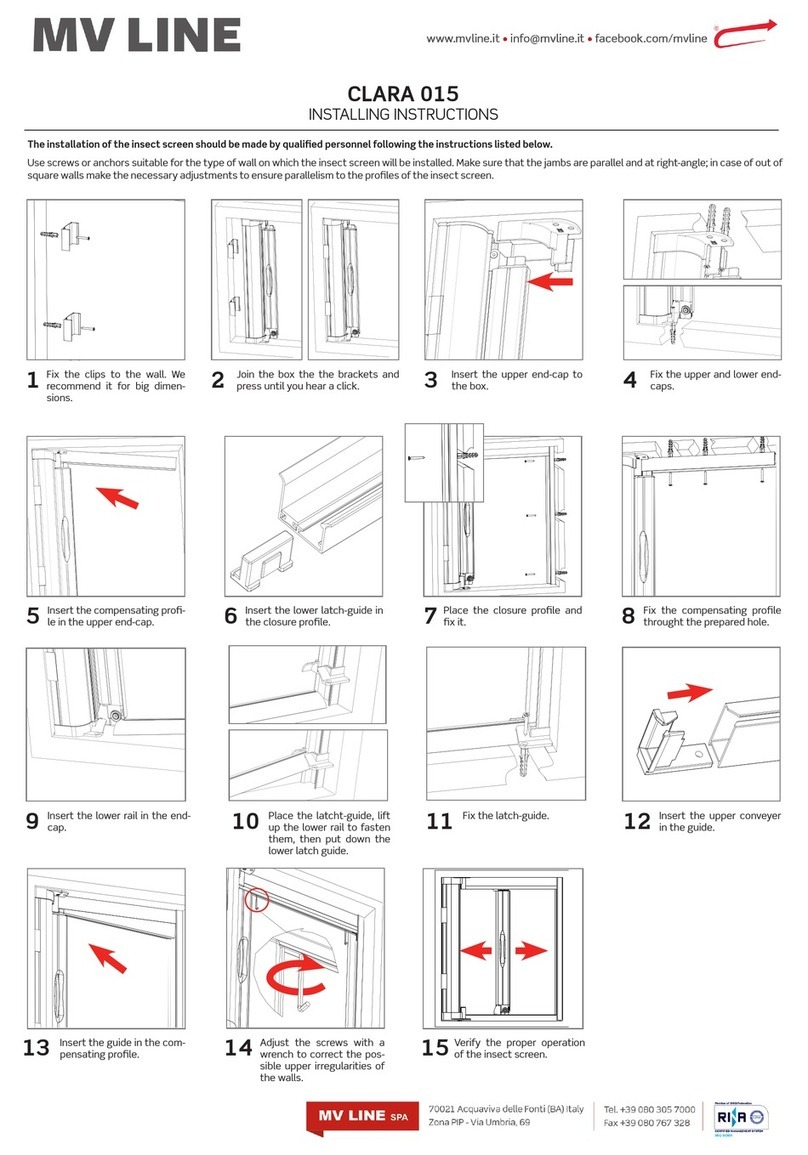
►DESCRIZIONE
Motoriduttore tubolare per avvolgibili e tende da sole
ad uso intermittente (tempo di funzionamento: 4 minuti
prima dell’intervento del protettore termico).
Per la coppia di torsione occorre riferirsi a quanto indicato
nei dati di targa su ciascun modello. Verificare che la cop-
pia ed il tempo di funzionamento indicati sulla targa siano
compatibili con l’avvolgibile/tenda da motorizzare.
►INSTALLAZIONE (Fig. 1)
Per l’installazione, il motoriduttore deve essere completato con una
coppia di adattatori (corrispondenti con il rullo avvolgitore) e con una
piastra di sostegno. Per gli accessori vogliate riferirvi al ns. catalogo di
vendita.
ATTENZIONE: l’installazione non corretta può causare gravi feri-
te. Seguire tutte le istruzioni di installazione. Prima dell’instal-
lazione rimuovere tutti i cavi superflui e disattivare qualunque
apparecchiatura presente non necessaria per il funzionamento.
- Applicare gli adattatori sul motoriduttore distinguendo l’anello di
comando del finecorsa (Fig. 1.1 A) dalla puleggia motrice (Fig. 1.2 B).
- La piastra di sostegno del motoriduttore (C) va fissata all’interno del
cassonetto o sull’armatura della tenda in modo che il rullo avvolgito-
re (F) sia perfettamente in orizzontale ed ad un’altezza
non inferiore a 1,8m.
- Infilare il motoriduttore (E) nel rullo avvolgitore (F) fino a che
l’estremità dello stesso sia sulla battuta dell’anello di comando del
finecorsa (Fig. 1.3).
- [Per XQ 50] Appoggiare il perno quadro (D) del motoriduttore
nella piastra di sostegno (C) e la calotta all’estremità opposta del
rullo sull’apposito supporto.
ATTENZIONE: Non battere mai sul perno quadro del motore per
introdurlo nel tubo.
• Per la serie 50 con coppia nominale fino a 15 Nm il diametro
minimo del rullo avvolgitore è di 50x1,5mm; per coppie supe-
riori il diametro minimo è di 60x1,5mm.
• Per la serie 60 il diametro minimo del rullo avvolgitore è di
63x1,5mm.
ATTENZIONE:
- Le viti di fissaggio della stecca sul rullo, non devono toccare la
parte tubolare del motoriduttore. Vogliate utilizzare delle viti
adatte o le clips di fissaggio.
- Parti in movimento del motore montate al di sotto di una
altezza di 2,5m dal suolo devono essere protette.
- L’installazione inadeguata del motoriduttore può provocare
danni a persone o cose.
►COLLEGAMENTO ELETTRICO (Fig. 2)
Controllare che la tensione di rete disponibile sull’im-
pianto sia quella indicata sull’etichetta. Il collegamento alla
rete del motoriduttore deve essere eseguito, secondo lo schema a
pagina seguente, da tecnici qualificati in grado di operare nel rispetto
delle norme.
ATTENZIONE: Nella rete di alimentazione deve essere presente
un dispositivo di sezionamento con distanza di apertura tra i
contatti di almeno 3mm.
MOTORITUBOLARI CON FINECORSA ELETTRONICO
AD ENCODER - ISTRUZIONI
TUBULAR MOTORSWITH ENCODER ELECTRONIC
LIMITS - INSTRUCTIONS
MOTEURSTUBULAIRES AVEC FINS DE COURSES
ÉLECTRONIQUES À ENCODEUR - INSTRUCTIONS
ROHRMOTOREN MIT ELEKTRONISCHER ENDABSCHALTUNG UND
INTEGRIERTEM FUNKEMPFÄNGER - ANWEISUNGEN
MOTORESTUBULARES CON FINAL DE CARRERA ELECTRÓNICO
CON ENCODER - INSTRUCCIONES
IT
EN
FR
ES
DE
È IMPORTANTE PER LA SICUREZZA DELLE PERSONE SEGUIRE ATTENTAMENTE QUESTE ISTRUZIONI.
CONSERVARE QUESTE ISTRUZIONI. IMPORTANTE:
•Osservarel’avvolgibiledurantel’azionamentoetenerelontanelepersonenchèquestoèinmovimento.
•Esaminarefrequentementesevisonosbilanciamentiosegnidiusuraodanneggiamentodeicavi.Nonutilizzare
seviènecessitàdiriparazioneomanutenzione
•Nelcasodiutilizzosutendedasolecontrollarecheilcampodimovimentazionedellatendasialiberodaqualsiasi
oggettossoconunmarginedialmeno0,4m.
•L’apparecchiononèdestinatoadessereusatodapersone(bambinicompresi)lecuicapacitàsiche,sensoriali
omentalisianoridotte,oppureconmancanzadiesperienzao conoscenza,amenocheesse abbianopotuto
beneciare,attraversol’intermediazionediunapersonaresponsabiledellalorosicurezza,diunasorveglianzaodi
istruzioniriguardantil’usadell’apparecchio.
•Ibambini devonoesseresorvegliatiper sincerarsi chenongiochinoconl’apparecchioe/o conidispositividi
comandossi.
•Idispositividicontrolloinstallatiinmanierassadevonoessereposizionatiavista.
CAREFULLY FOLLOW THESE INSTRUCTIONS. IT IS VERY IMPORTANT FOR THE SAFETY OF PERSONS.
SAVE THESE INSTRUCTIONS. IMPORTANT:
•Checktheshutter/awninginmotionandkeeppersonsfarfromitwhileinaction.
•Frequentlycheckifanylossofbalance,signsofwearordamagedwiresareshown.
•Donotuseifanyrepairingormaintenanceisneeded.
•Incaseofinstallationinawningskeepadistanceofatleast0,4mfromit(completelyopen)andwhateverxed
iteminthenearby.
•Thedeviceisnotintendedtobeusedbypeople(includingchildren)whosephysical,sensoryormentalcapabili-
tiesarereduced,orlackingexperienceorknowledge,unlesstheyhavebeengrantedthroughtheintermediaryof
apersonresponsiblefortheirsafety,supervisionorinstructionconcerningtheuseofthedevice.
•Childrenshouldbesupervisedtoensuretheydonotplaywiththedeviceand/orwithxcontroldevices.
•Thecontroldevicesinstalledinaxedmannermustbepositionedinview.
IL EST IMPORTANT POUR LA SÉCURITÉ DES PERSONNES A SUIVRE ATTENTIVEMENT CES INSTRUCTIONS.
CONSERVER CE MANUEL. IMPORTANT:
•Suivrelevolet/storelorsdel’entraînementetleteniréloignédesgensjusqu’àcequ’ilestenmouvement.
•Examinerfréquemmentsi il ya des déséquilibres ou des signes d’usure ou de dommages aux câbles.Nepas
utilisersiilyabesoinderéparationoud’entretien.
•Encasd’utilisationdestorescontrôlerquelemouvementdustoresoitlibredetoutobjetxeavecunemarge
d’aumoins0,4m.
•L’appareiln’estpasdestinéàêtreutilisépardespersonnes(ycomprislesenfants)dontlescapacitésphysiques,
sensoriellesoumentalessontréduites,oulemanqued’expérienceoudeconnaissance,saufsiellesontbénécié,
parl’intermédiaired’une personneresponsabledeleur sécurité, de surveillanceoud’instructionsconcernant
l’utilisationdel’appareil.
•Lesenfantsdoiventêtresurveilléspours’assurerqu’ilsnejouentpasavecl’appareilet/oudesdispositifsdecontrôlexes.
•Lesdispositifsdecontrôleinstallésdemanièrexedoiventêtrepositionnésdemanièrequ’ilssoientvisibles.
ES IST SEHR WICHTIG FÜR DIE SICHERHEIT DER PERSONEN, DASS DIESE EINLEITUNGEN AUFMERKSAM BEFOLGT
SIND. DIESE EINBAUANLEITUNGEN AUFBEWAHREN. WICHTIG:
•BeachtenSiedenRollladenwährendderFahrtundPersonenfernhalten,biserinBewegungist.
•Esisthäugzukontrollieren,obesUngleichgewichte,VerschleißerscheinungenoderKabelbeschädigungengibt.
FürdenFall,dassReparaturenoderWartungennötigsind,betriebenSiedenMotornicht.
•FürdenEinsatzaufMarkisenisteinhorizontalerAbstandvonmindestens0,4mzwischendemvollständigausge-
rolltenangetriebenenTeilundjeglichemfestverlegtenGegenstandeinzuhalten.
•DasGerätistnichtzurVerwendungbestimmt,vonPersonen(einschließlichKinder),derenphysische,sensorische
odergeistige Fähigkeitenreduziert sind, oder vonPersonen,die an Erfahrungoder Kenntnis mangeln. Diese
KategorienvonPersonenbenötigenAufsichtundAnweisungenzurBenutzungdesSystemsdurchdieVermit-
tlungeinerPerson,dieverantwortlichfürihreSicherheitist.
•Kindersolltenbeaufsichtigtwerden,umsicherzustellen,dasssie nichtmitdemGerät und/oderfestenSteue-
reinrichtungenspielen.
•FestmontierteSteuereinrichtungenmüssensichtbarangebrachtwerden.
ES IMPORTANTE PARA LA SEGURIDAD DE LAS PERSONAS SEGUIR ATENTAMENTE ESTAS INSTRUCCIONES.
GUARDE ESTAS INSTRUCCIONES. IMPORTANTE:
•Observarlapersianaóeltoldoduranteelaccionamientoytenerlejosalaspersonasmientrasestaenmovimiento.
•Examinar frecuentementesi hay desequilibrioso daños de uso en elcable. No utilizar si se venecesidad de
sustituiroreparar.
•Enelcasodeutilizarsobretoldos,controlarqueelcampodemovimientodeltoldoestelibredecualquierobjeto
joconunmargendealmenos0,4m.
•Eldispositivonoestádestinadoaserutilizadoporpersonas(incluidosniños)cuyasfacultadesfísicas,sensoriales
o mentales sean reducidas, o con falta de experiencia o conocimiento, a menos que se les haya concedido
permiso,atravésdelamediacióndeunapersonaresponsabledesuseguridad,supervisadosoinstruidosacerca
delusodeldispositivo.
•Losniñosdebensersupervisadosparaasegurarsedequenojueguenconeldispositivoycondispositivosde
controljos.
•Losdispositivosdecontrolinstaladosdeformajadebenposicionarsedemaneraqueseanvisibile.
6ISTRE
I cavi di collegamento alla rete di questi motori possono essere
sostituiti soltanto con cavi dello stesso tipo forniti dal produttore dei
motori (Fig. 4).
- Se il motoriduttore gira in senso inverso (l’avvolgibile o tenda si
chiude con il comando apertura o viceversa) occorre invertire i
conduttori esterni.
- Non azionare l’avvolgibile/tenda quando si stanno compiendo delle
pulizie o manutenzione e scollegare l’alimentazione.
- L’interruttore che aziona l’apparecchio deve essere installato in vista
dell’automazione ad una altezza non superiore a 1,5 m e lontano da
parti in movimento.
►INFORMAZIONI IMPORTANTI PER GLI ELETTRICISTI
- Per il funzionamento normale del motore deve essere utilizzato solo
un interruttore standard che consente la SALITA o la DISCESA, ma
non contemporaneamente. Possono essere utilizzati solo interruttori
interbloccanti meccanicamente o elettricamente.
- I motori con finecorsa elettronici possono essere collegati in paralle-
lo. Il carico massimo dell’interruttore non si deve mai superare.
- Quando si inverte dalla SALITA alla DISCESA o viceversa, il tempo
di commutazione deve essere di almeno 0,5 secondi e si deve
passare attraverso una posizione OFF. Possono essere utilizzati solo
interruttori con una posizione neutra definita o con un ritardatore di
commutazione integrato.
- Centraline intelligenti che controllano l’assorbimento di corrente
sono in conflitto con il motore e non possono essere utilizzate.
►REGOLAZIONE FINECORSA (Fig. 3)
Il motoriduttore viene fornito con i finecorsa preregolati per circa due
giri in entrambi i sensi di rotazione.
IMPORTANTE: Le procedure di regolazione sotto indicate sono
valide sia con il motoriduttore a destra che a sinistra del rullo
avvolgitore.
►REGOLAZIONE TRAMITE PULSANTIERA ACPRE (opzionale) -
Fig. 3.1
IMPORTANTE: Il primo finecorsa da regolare è sempre quello di
SALITA
Caso 1.Sulla tapparella sono presenti i BLOCCHI DI SICUREZZA
(finecorsa fisico)
- Collegare il motore alla pulsantiera di regolazione ACPRE;
- Premere i 2 pulsanti contemporaneamente per 15 secondi, il motore
si muove brevemente nei due sensi di rotazione per circa 1 secondo.
- Premere sul pulsante di SALITA e fare arrivare la tapparella sul blocco
di sicurezza SALITA, in questo modo il finecorsa salita è regolato;
- Premere sul pulsante DISCESA e regolare il finecorsa DISCESA con
l’aiuto della pulsantiera;
- Premere i 2 pulsanti contemporaneamente per 15 secondi, il motore
si muove brevemente nei due sensi di rotazione per circa 1 secondo.
In questo modo il finecorsa DISCESA è regolato.
- Scollegare la pulsantiera ACPRE e collegare la pulsantiera standard.
Caso 2. Sulla tapparella non sono presenti i BLOCCHI DI
SICUREZZA (finecorsa virtuale)
- Collegare il motore alla pulsantiera di regolazione ACPRE;
- Premere i 2 pulsanti contemporaneamente per 15 secondi, il motore
si muove brevemente nei due sensi di rotazione per circa 1 secondo.
- Premere sul pulsante SALITA e regolare il finecorsa SALITA con l’aiuto
della pulsantiera;
- Premere i 2 pulsanti contemporaneamente per 15 secondi, il motore
si muove brevemente nei due sensi di rotazione per circa 1 secondo.
In questo modo il finecorsa SALITA è regolato.
- Premere sul pulsante DISCESA e regolare il finecorsa DISCESA con
l’aiuto della pulsantiera;
- Premere i 2 pulsanti contemporaneamente per 15 secondi, il motore
si muove brevemente nei due sensi di rotazione per circa 1 secondo.
In questo modo il finecorsa DISCESA è regolato.
- Scollegare la pulsantiera ACPRE e collegare la pulsantiera standard.
►REGOLAZIONE TRAMITE PULSANTIERA STANDARD
Fig. 3.2 [solo per XQ50]
Caso 1. Sulla tapparella sono presenti i BLOCCHI DI SICUREZZA
(finecorsa fisico)
- Premere il pulsante bianco che si trova sulla testa motore e uno dei
2 pulsanti della pulsantiera standard per 15 secondi, il motore si
muove brevemente nei due sensi di rotazione per circa 1 secondo.
- Premere sul pulsante di SALITA e fare arrivare la tapparella sul blocco
di sicurezza SALITA, in questo modo il finecorsa salita è regolato;
- Premere sul pulsante DISCESA e regolare il finecorsa DISCESA con
l’aiuto della pulsantiera;
- Premere il pulsante bianco che si trova sulla testa motore e uno dei
2 pulsanti della pulsantiera standard per 15 secondi, il motore si
muove brevemente nei due sensi di rotazione per circa 1 secondo.
In questo modo il finecorsa DISCESA è regolato.
Caso 2. Sulla tapparella non sono presenti i BLOCCHI DI
SICUREZZA (finecorsa virtuale)
- Premere il pulsante bianco che si trova sulla testa motore e uno dei
2 pulsanti della pulsantiera standard per 15 secondi, il motore si
muove brevemente nei due sensi di rotazione per circa 1 secondo.
- Premere sul pulsante SALITA e regolare il finecorsa SALITA
con l’aiuto della pulsantiera;
- Premere il pulsante bianco che si trova sulla testa motore e uno dei
2 pulsanti della pulsantiera standard per 15 secondi, il motore si
muove brevemente nei due sensi di rotazione per circa 1 secondo.
In questo modo il finecorsa SALITA è
regolato.
- Premere sul pulsante DISCESA e regolare il finecorsa DISCESA
con l’aiuto della pulsantiera;
- Premere il pulsante bianco che si trova sulla testa motore e uno dei
2 pulsanti della pulsantiera standard per 15 secondi, il motore si
muove brevemente nei due sensi di rotazione per circa 1 secondo.
In questo modo il finecorsa DISCESA è regolato.
IT
GAPOSA srl - via Ete, 90 - 63900 Fermo - Italy - T. +39.0734.220701 - F. +39.0734.226389

